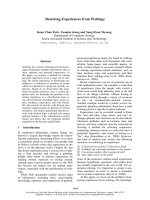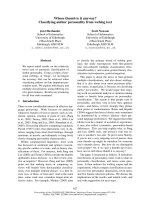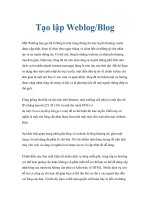10websecurity xuanhiens weblog
Bạn đang xem bản rút gọn của tài liệu. Xem và tải ngay bản đầy đủ của tài liệu tại đây (602.37 KB, 21 trang )
<span class='text_page_counter'>(1)</span><div class='page_container' data-page=1>
<b>WEB SYSTEMS & </b>
<b>TECHNOLOGIES</b>
</div>
<span class='text_page_counter'>(2)</span><div class='page_container' data-page=2>
<b>Table of Content</b>
<b>Web Security Facts </b>
<b>Web Communication Fundamentals</b>
<b>Popular Web Application Attacks</b>
</div>
<span class='text_page_counter'>(3)</span><div class='page_container' data-page=3>
<b>Web Security Facts</b>
<b>White Security Statistics Report </b>
<b>2015</b>
<b>86% of all websites tested by </b>
<b>Whitehat Sentinen had at least one </b>
<b>serious vulnerability, and most of </b>
<b>the time, far more than one.</b>
<b>90,9 % of the explointed </b>
<b>vulnerabilities were compromised </b>
<b>more than a year after the Common </b>
<b>Vulnerability and Exposures (CVE) </b>
<b>record was published.</b>
<b>500 million dollars – the damages </b>
<b>Ashley Madison was already facing </b>
<b>via lawsuits filed only one week </b>
</div>
<span class='text_page_counter'>(4)</span><div class='page_container' data-page=4>
<b>Web Communication </b>
<b>Fundamentals</b>
<b>HTTP</b>
<b>GET vs. POST Security</b>
<b>Web Sites vs. Web Application</b>
<b>Web Applications Breach the </b>
</div>
<span class='text_page_counter'>(5)</span><div class='page_container' data-page=5>
<b>Hypertext Transfer Protocol </b>
<b>- HTTP</b>
<b>Hypertext Transfer Protocol </b>
<b>(HTTP) is a communications </b>
<b>protocol for the transfer of </b>
<b>information on intranets and the </b>
<b>World Wide Web. Its original </b>
<b>purpose was to provide a way to </b>
<b>publish and retrieve hypertext </b>
<b>pages over the Internet.”</b>
<b> />
<b>Request</b>
<b>Response</b>
<b>Server</b>
<b>www.mybank.com</b>
<b>(64.58.76.230)</b>
<b>Port: 80</b>
</div>
<span class='text_page_counter'>(6)</span><div class='page_container' data-page=6>
<b>HTTP Request - GET</b>
<b>Form data encoded in the URL</b>
<b>Most common HTTP method used </b>
<b>on the web</b>
<b>Should be used to retrieve </b>
</div>
<span class='text_page_counter'>(7)</span><div class='page_container' data-page=7>
<b>HTTP Request - GET</b>
<b>GET </b> </b>
HTTP/1.1
Host: www.mysite.com
User-Agent: Mozilla/5.0 (Windows; U; Windows NT 5.1;
en-US; rv:1.8.1.13) Gecko/20080311 Firefox/2.0.0.13
Accept:
text/xml,application/xml,application/xhtml+xml,text/html;q
=0.9,text/plain;q=0.8,image/png,*/*;q=0.5
Accept-Language: en-us,en;q=0.5
Accept-Encoding: gzip,deflate
Accept-Charset: ISO-8859-1,utf-8;q=0.7,*;q=0.7
Keep-Alive: 300
Connection: keep-alive
</div>
<span class='text_page_counter'>(8)</span><div class='page_container' data-page=8>
<b>HTTP Requests - POST</b>
<b>Data is included in the body of the </b>
<b>request. </b>
<b>Should be used for any action that has </b>
<b>side-effects</b>
<b>Storing/updating data, ordering a product, </b>
<b>etc…</b>
<b>Tool: Chrome Add-in Postman:</b>
<b><sub>Demo: Change GET</sub></b>
<b> />
</div>
<span class='text_page_counter'>(9)</span><div class='page_container' data-page=9>
<b>GET v. POST Security</b>
<b>There information contained in </b>
<b>parameters can tell a user a lot </b>
<b>about how your application works</b>
<b>GET parameters are easily visible </b>
<b>in the address bar</b>
<b>POST parameters are hidden from </b>
<i><b>the average user</b></i>
<b>Users can still view source code</b>
<b>Users can still view the packets</b>
<b>Users can still intercept & modify web </b>
</div>
<span class='text_page_counter'>(10)</span><div class='page_container' data-page=10>
<b>Web Sites</b>
<b>No applications</b>
<b>Static pages</b>
<b>Hard coded links</b>
</div>
<span class='text_page_counter'>(11)</span><div class='page_container' data-page=11>
<b>Web Applications</b>
<b>Browse</b>
<b>r</b>
<b>Web Servers</b>
<b>Presentation </b>
<b>Layer</b>
<b>Media Store</b>
</div>
<span class='text_page_counter'>(12)</span><div class='page_container' data-page=12>
<b>Web Applications Breach the Perimeter</b>
<b>Internet</b> <b>DMZ</b> <b>Trusted </b>
<b>Inside</b>
<b>Corporate </b>
<b>Inside</b>
<i>HTTP(S)</i>
Allows HTTP port 80
Allows HTTPS port 443
Firewall only
allows
applications
on the web
server to talk to
application
server.
</div>
<span class='text_page_counter'>(13)</span><div class='page_container' data-page=13>
<b>Popular Web Attacks</b>
<b>Why Web Application </b>
<b>Vulnerabilities Occur</b>
<b>Web Application Vulnerabilities</b>
<b>OWASP – 10 Most Critical Web </b>
</div>
<span class='text_page_counter'>(14)</span><div class='page_container' data-page=14>
“As an
Application
Developer, I can
build great
features and
functions while
meeting
deadlines, but I
don’t know how
to develop my
web application
with security as a
feature.”
<b>The Web Application</b>
<b>Security Gap</b>
“As a Network
Security Professional,
I don’t know how my
companies web
applications are
supposed to work so
I deploy a protective
solution…but don’t
know if it’s
protecting what it’s
supposed to.”
Application
Developers and
QA
Professionals
Don’t Know
Security
<b>Why Web Application Vulnerabilities Occur</b>
Security
Professionals
Don’t Know
The
</div>
<span class='text_page_counter'>(15)</span><div class='page_container' data-page=15>
<b>Web Application </b>
<b>Vulnerabilities</b>
<b>Web application vulnerabilities </b>
<b>occur in multiple areas.</b>
<b>Platform</b>
<b>Administration</b>
<b>Application</b>
Known Vulnerabilities
</div>
<span class='text_page_counter'>(16)</span><div class='page_container' data-page=16>
<b>Common coding techniques do not </b>
<b>necessarily include security</b>
<b>Input is assumed to be valid, but not </b>
<b>tested </b>
<b>Unexamined input from a browser can </b>
<b>inject scripts into page for replay </b>
<b>against later visitors</b>
<b>Unhandled error messages reveal </b>
<b>application and database structures</b>
<b>Unchecked database calls can be </b>
<b>‘piggybacked’ with a hacker’s own </b>
<b>database call, giving direct access to </b>
<b>business data through a web browser</b>
</div>
<span class='text_page_counter'>(17)</span><div class='page_container' data-page=17>
<b>OWASP – 10 Most Critical Web </b>
<b>Application Security Risks</b>
<b>https://</b>
<b></b>
<b>www.owasp.org/index.php/Top_10_2013-Top_10</b>
<b>1.</b> <b>A1 Injection.</b>
<b>2.</b> <b>A2 Broken Authentication and Session </b>
<b>Management.</b>
<b>3.</b> <b>A3 Cross-Site Scripting (XSS)</b>
<b>4.</b> <b>A4 Insecure Direct Object References.</b>
<b>5.</b> <b>A5 Security Misconfiguration.</b>
<b>6.</b> <b>A6 Sensitive Data Exposure.</b>
<b>7.</b> <b>A7 Missing Function Level Access </b>
<b>Control.</b>
<b>8.</b> <b>A8 Cross-Site Request Forgery (CSRF)</b>
<b>9.</b> <b>A9 Using Components with Known </b>
<b>Vulnerabilities</b>
<b>10.A10 Unvalidated Redirects and </b>
</div>
<span class='text_page_counter'>(18)</span><div class='page_container' data-page=18></div>
<span class='text_page_counter'>(19)</span><div class='page_container' data-page=19>
<b>How to Secure Web </b>
<b>Applications</b>
<b>Incorporating security into </b>
<b>lifecycle</b>
<b>Integrate security into </b>
<b>application requirements</b>
<b><sub>Including information security </sub></b>
<b>professionals in software </b>
<b>architecture/design review</b>
<b>Security APIs & libraries (e.g. </b>
<b>ESAPI, Validator, etc.) when </b>
<b>possible</b>
<b>Threat modeling</b>
<b>Web application vulnerability </b>
</div>
<span class='text_page_counter'>(20)</span><div class='page_container' data-page=20>
<b>How to Secure Web </b>
<b>Applications</b>
<b>Educate</b>
<b><sub>Developers – Software security best </sub></b>
<b>practices</b>
<b>Testers – Methods for identifying </b>
<b>vulnerabilities</b>
<b>Security Professionals – Software </b>
<b>development, Software coding best </b>
<b>practices</b>
<b>Executives, System Owners, etc. – </b>
</div>
<span class='text_page_counter'>(21)</span><div class='page_container' data-page=21>
<b>Questions</b>
<b>?</b>
<b>?</b>
<b>?</b>
?
?
<b>?</b>
<b>?</b>
?
?
?
?
</div>
<!--links-->
Tài liệu Báo cáo khoa học: "Mood Patterns and Affective Lexicon Access in Weblogs" ppt
- 6
- 415
- 0








